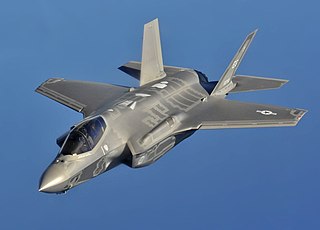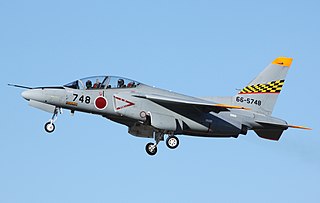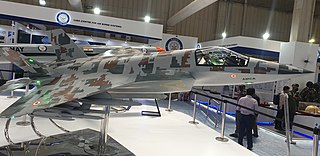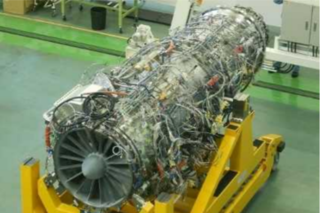
The i3 Fighter is a conceptual jet fighter proposed by the Ministry of Defense of Japan in 2010 in association with development of the successor to the Mitsubishi F-2 fighter. The i3 stands for Informed, Intelligent and Instantaneous.

The i3 Fighter is a conceptual jet fighter proposed by the Ministry of Defense of Japan in 2010 in association with development of the successor to the Mitsubishi F-2 fighter. The i3 stands for Informed, Intelligent and Instantaneous.
With modernization and expansion of the People's Liberation Army Air Force and Russian Aerospace Forces accelerating, the Japan Air Self-Defense Force (JASDF) envisaged a mass deployment of Chinese as well as Russian 4.5th and 5th generation fighters in the region in the near future, and, in 2010, issued a report to call for development of a new generation high performance fighter to compensate for numerical inferiority and secure air superiority in such an environment. The report, A vision for research and development of future fighter, [1] stressed the importance of indigenous development to maintain domestic fighter manufacturing base, and proposed a counter-stealth fighter capable of detecting enemy stealth aircraft with its combat information system composed of high-power radar, advanced sensor suite and tactical link with external sensor nodes and accompanying UAVs, and defeating them with network-based team tactics. It features advanced stealth capabilities, a fly-by-light flight control system, slim high-power engines, advanced sensor suite, "cloud shooting" capability (networked fire control), and directed energy weapons called "light-speed weapon". This highly 'informed' and 'intelligent' platform to destroy enemies 'instantaneously' with high-efficient shooting and light-speed weapons was named as i3 FIGHTER.


A rough roadmap included in the report shows that the development takes over two decades, with the first half as the preliminary research phase, and the latter, starting in the early 2020s, for full-scale development. Although the i3 FIGHTER is described as a potential successor to the Mitsubishi F-2, the exact connection between these two is murky, and even if it is the successor, the degree to which the proposed features will be integrated to the final design remains unclear as well. Even so, the F-2 successor programme (Future Fighter, often referred to as F-3) is known to have much in common with the i3 FIGHTER plan; and researches conducted and disclosed by the Acquisition, Technology & Logistics Agency (ATLA) responsible for the future fighter research have been largely in line with the technologies and schedule introduced in the report. [2] [3] [4] In 2018, a prototype of the High-power Slim Engine, the IHI XF9-1, was delivered "on schedule". [5] Similarly, in 2019, the Ministry of Defense included the budget for development of the F-2 successor in the FY 2020 budget request, [6] [7] suggesting that the full-scale development was about to be initiated in the time frame consistent with the roadmap. On April 1 2020 the MoD officially launched the programme as F-X.

Fighter aircraft are military aircraft designed primarily for air-to-air combat. In military conflict, the role of fighter aircraft is to establish air superiority of the battlespace. Domination of the airspace above a battlefield permits bombers and attack aircraft to engage in tactical and strategic bombing of enemy targets, and helps prevent the enemy from doing the same.

The Lockheed Martin F-35 Lightning II is an American family of single-seat, single-engine, supersonic stealth strike fighters. A multirole combat aircraft designed for both air superiority and strike missions, it also has electronic warfare and intelligence, surveillance, and reconnaissance capabilities. Lockheed Martin is the prime F-35 contractor with principal partners Northrop Grumman and BAE Systems. The aircraft has three main variants: the conventional takeoff and landing (CTOL) F-35A, the short take-off and vertical-landing (STOVL) F-35B, and the carrier variant (CV) catapult-assisted take-off but arrested recovery (CATOBAR) F-35C.

The fourth-generation fighter is a class of jet fighters in service from around 1980 to the present, and represents design concepts of the 1970s. Fourth-generation designs are heavily influenced by lessons learned from the previous generation of combat aircraft. Third-generation fighters were often designed primarily as interceptors, being built around speed and air-to-air missiles. While exceptionally fast in a straight line, many third-generation fighters severely lacked in maneuverability, as doctrine held that traditional dogfighting would be impossible at supersonic speeds. In practice, air-to-air missiles of the time, despite being responsible for the vast majority of air-to-air victories, were relatively unreliable, and combat would quickly become subsonic and close-range. This would leave third-generation fighters vulnerable and ill-equipped, renewing an interest in manoeuvrability for the fourth generation of fighters. Meanwhile, the growing costs of military aircraft in general and the demonstrated success of aircraft such as the McDonnell Douglas F-4 Phantom II gave rise to the popularity of multirole combat aircraft in parallel with the advances marking the so-called fourth generation.

The Kawasaki T-4 is a Japanese subsonic intermediate jet trainer aircraft developed and manufactured by the commercial conglomerate Kawasaki Heavy Industries. Its sole operator is the Japan Air Self-Defense Force (JASDF), in part due to historic restrictions on the exporting of military hardware. In addition to its primary training mission, the T-4 has been used by the JASDF's Blue Impulse aerobatic team as well as liaison duties with most fighter units. The first XT-4 prototype flew on 29 July 1985, while the first production aircraft was delivered during September 1988.

The Japanese defense industry is the part of the Japanese economy responsible for the procurement of military technology, primarily for the nation's own Self-Defense Forces, largely due to a strict policy on national exports.

The Advanced Medium Combat Aircraft (AMCA) is an Indian single-seat, twin-engine, all-weather fifth-generation stealth, multirole combat aircraft being developed for the Indian Air Force and the Indian Navy. The Mark-1 variant of the aircraft will be a fifth generation fighter while the Mark-2 variant will have sixth-generation technologies. The aircraft is designed by the Aeronautical Development Agency (ADA) - an aircraft design agency under MoD. A Special Purpose Vehicle (SPV) consisting of ADA, Hindustan Aeronautics Limited (HAL) and a private company is being formed for the development and production of AMCA. In March 2024, the project received approval from India's Cabinet Committee on Security for the prototype development and mass production expected to begin by 2035.
The AL-41 is a designation for two different Russian military turbofan engine variants by NPO Lyulka-Saturn. The original AL-41F, development designation izdeliye20, was a variable-bypass ratio turbofan engine, designed for supercruise flight for the MFI program, which resulted in the Mikoyan Project 1.44. It is considered by Jane's as the Russian counterpart to the General Electric YF120 engine which lost to the more conventional fixed-bypass YF119 in the Advanced Tactical Fighter engine program.

The Mitsubishi X-2 Shinshin is a Japanese experimental aircraft for testing advanced stealth fighter aircraft technologies. It is being developed by the Japanese Ministry of Defense Technical Research and Development Institute (TRDI) for research purposes. The main contractor of the project is Mitsubishi Heavy Industries. Many consider this aircraft to be Japan's first domestically made stealth fighter. ATD-X is an abbreviation for "Advanced Technology Demonstrator – X". The aircraft is widely known in Japan as Shinshin although the name itself is an early code name within the Japan Self-Defense Forces and is not officially in use. The aircraft's first flight was on 22 April 2016.

A fifth-generation fighter is a jet fighter aircraft classification which includes major technologies developed during the first part of the 21st century. As of 2024, these are the most advanced fighters in operation. The characteristics of a fifth-generation fighter are not universally agreed upon, and not every fifth-generation type necessarily has them all; however, they typically include stealth, low-probability-of-intercept radar (LPIR), agile airframes with supercruise performance, advanced avionics features, and highly integrated computer systems capable of networking with other elements within the battlespace for situational awareness and C3 (command, control and communications) capabilities.

A sixth-generation fighter is a conceptualized class of jet fighter aircraft design more advanced than the fifth-generation jet fighters that are currently in service and development. Several countries have announced the development of a national sixth-generation aircraft program, including the United States, Russia and China. Whilst other countries have joined collaborative multinational projects such as Japan, Italy and the United Kingdom with Global Combat Air Programme, and France, Germany and Spain with FCAS; in order to spread development and procurement costs. The first sixth-generation fighters are expected to enter service in the 2030s.
The Mikoyan LMFS Liogkiy Mnogofunktsionalniy Frontovoi Samolyet (LMFS)—or Light Multi-Function Frontline Aircraft, also known as the MiG-XX, was a proposed light Russian single-seat all-weather stealth multirole combat aircraft. The design is derived from the company’s PAK FA proposal, which was rejected in favor of Sukhoi's, along with lessons learned from the cancelled Mikoyan MiG-1.42/1.44. It was supposed to replace the Mikoyan MiG-29 and MiG-35 and be a more affordable complement to the PAK FA, which became the Sukhoi Su-57. However, by 2021, the project was no longer under development, while Sukhoi unveiled its own LTS medium-weight single-engine stealth fifth-generation fighter.
F/A-XX is a development and acquisition program for a future sixth-generation air superiority fighter to replace the United States Navy's F/A-18E/F Super Hornet and complement the F-35C beginning in the 2030s. A requirement was first identified in June 2008.
Jet fighter generations classify the major technology leaps in the historical development of the jet fighter. Different authorities have identified different technology jumps as the key ones, dividing fighter development into different numbers of generations. Five generations are now widely recognised, with the development of a sixth under way.

The Defense Acquisition Program Administration was founded on 1 January 2006 as part of a comprehensive reform of the defense acquisition project, including the introduction and development of military equipments, and is a central administrative agency of the South Korean Ministry of National Defense. The DAPA has exclusive authority to plan and budget defense development and procurement programs for the Republic of Korea Armed Forces and to enact Korean Defense Specifications (KDS). Sub-agencies of DAPA include the Agency for Defense Development (ADD) responsible for defense development and Defense Agency for Technology and Quality (DTaQ) responsible for defense improvement programs and defense quality certification tests.

The BAE Systems Tempest is a proposed sixth-generation fighter aircraft that is under development in the United Kingdom for the Royal Air Force (RAF). The aircraft is intended to enter service from 2035, gradually replacing the Eurofighter Typhoon. It is being developed as part of the Future Combat Air System (FCAS) programme by a consortium known as Team Tempest, which includes the Ministry of Defence, BAE Systems, Rolls-Royce, the UK subsidiary of Leonardo, and MBDA UK. £2 billion is planned to be spent by the British government on the initial phase of the project up to 2025.

The Mogami-class frigate, also known as 30FFM, 30FF, 30DX, or 30DEX, is a Japanese multi-mission stealth frigate for the Japan Maritime Self-Defense Force (JMSDF).

The IHI XF9 is a low-bypass afterburning turbofan engine developed by the Acquisition, Technology & Logistics Agency (ATLA) of Ministry of Defense of Japan (MoD) and IHI Corporation.
The Acquisition, Technology & Logistics Agency is an agency established under the Japanese Ministry of Defense that handles project management, technology management, research and development, and procurement of defense equipment for the Japan Self-Defense Forces. ATLA is a part of the defense policy of then-Prime Minister Shinzō Abe to bolster the military by streamlining and reforming the country's defense industry and military equipment acquisition.

The Mitsubishi F-X is a sixth-generation stealth fighter in development for the Japan Air Self-Defense Force (JASDF). It is Japan's first domestically developed stealth fighter jet and will replace the Mitsubishi F-2 by the mid-2030s. Its development is to also bolster the nation's defense industry and potentially enter the international arms market amid Japan's change in defense posture. In October 2020, Mitsubishi Heavy Industries was selected as the lead developer.

The Global Combat Air Programme is a multinational initiative led by the United Kingdom, Japan, Italy to jointly develop a sixth-generation stealth fighter. The programme aims to replace the Eurofighter Typhoon in service with the Royal Air Force (RAF) and Italian Air Force, and the Mitsubishi F-2 in service with the Japan Air Self-Defense Force.
Limited details of the system provided by ministry officials to Aviation Week suggest the radar generates unusually high power, near the limit of what could be achieved.